Tuesday 24th January 2023

No; not the motorway although obviously the M4 does go to Bristol. The clue is in the lower case ‘m’. This is all about Bristol’s latest new bus route as part of the city’s metrobus branded network which began on Sunday.

The new route m4 runs from Cribbs Causeway to the city centre via Little Stoke, Stoke Gifford, Bristol Parkway railway station and the University of West of England campus at Frenchay.

It joins the m1, m2 and m3 routes which began in January 2019, September 2018 and May 2018 respectively. Four years on from that trio comes a fourth making for a quartet of routes as shown on the updated metrobus network map below.

The colour coding shown on the map is also used on the buses dedicated to each route which brightens up the otherwise grey landscape of the background metrobus livery.

The new m4 is operated by First West of England. Initially the m1 was sub-contracted to HCT owned Bristol Community Transport but when that business went bust last year First took it over meaning metrobus is now all operated by First.

The m4 kicks off at 06:00 from Cribbs Causeway on Mondays to Saturdays operating every 20 minutes through to 19:20 then half hourly until 23:25 with a half hourly frequency on Sundays between 08:30 and 19:55. The scheduled journey time from Cribbs Causeway to the city centre is around 42 minutes stretching to 54 minutes in the morning peak meaning the service take six buses with generous layover at the termini during the off peak.

Buses in the new m4 livery are four year old Scania/ADL Enviro400 City two-door powered by biogas. They’re comfortable to ride in giving a smooth journey and offer the usual usb sockets, audio announcements including a display on the lower deck …..

….. although no visual display on the upper deck advising what the next bus stop is.
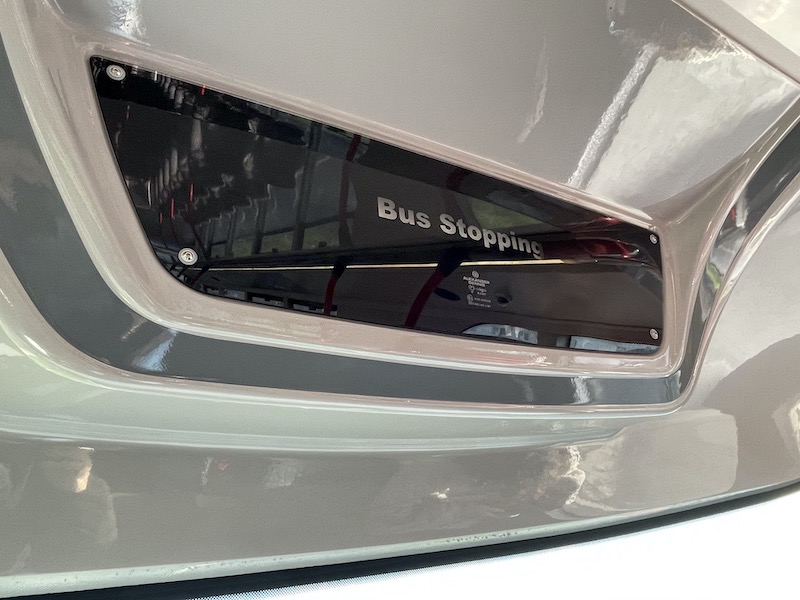
But there is a route map on the cove panel.

I had a ride up and down the route yesterday starting at 11:44 from Bristol Parkway railway station to Cribbs Causeway. It’s the first time a metrobus bus route has served the station.

It was good to see bus shelter timetable displays had been updated with departures for the m4 clearly shown, but there didn’t seem to be an iPoint where passengers can buy tickets. Metrobus operates a buy before travel arrangement with no tickets sold on the bus so I’m not sure what passengers are meant to do when boarding at Bristol Parkway if they don’t want to use a smartphone app or tap on and tap off with a bank card which looked to be the only options. (Update: I’m advised there is one iPoint on the walk to the city centre bound bus stop which I didn’t see on my visit)
Other bus stops exclusively served by the m4 on the route had had the ‘metrobus’ makeover including an iPoint, so I’m not sure why Bristol Parkway has missed out.

Infrastructure developments as part of the m4 introduction include a new railway bridge on Gipsy Patch Lane in Lower Stoke. Here it is before…..

… and after….
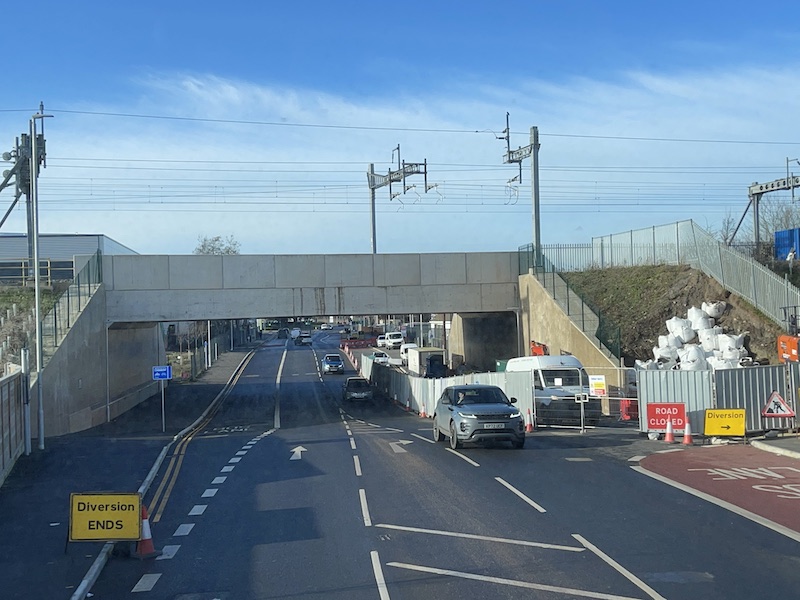
….. as well as a new bus lane.

I noticed the bus stop towards Cribbs Causeway at the eastern end of Gipsy Patch Lane had white hatch markings which motorists were happily driving over as buses were at the bus stop.


There were about 15 passengers on board heading towards Cribbs Causeway (which is where a huge out-of-town retail park called The Mall is located) which you might think is very good going for the first weekday morning of a new bus route but the m4 has been introduced along with some cut backs to other services.
Hourly route 19 which used to run from Bath to Cribbs Causeway now only goes as far as Bristol Parkway where passengers have to change buses to continue onwards to Cribbs Causeway which obviously hasn’t gone down too well. Another change involves route 73 terminating at Bradley Stoke (just north of Bristol Parkway) instead of continuing on to Cribbs Causeway.
The m4 takes a quicker route between Bristol Parkway and Cribbs Causeway than either the 19 and 73, so it does provide a faster journey.
There are plans to divert the route through a huge housing development called Brabazon on the site of the former Filton airfield once building starts.

Arriving in Cribbs Causeway at just after 12:00 I saw the 12:00 departure for the city centre still on the stand so ‘stepped up’ my plan and caught that for my southbound journey to the city centre just as it was leaving.

As you can see it was an m3 green coloured bus which had apparently substituted for a breakdown earlier that morning, but it did cause some confusion for passengers during the journey not least when we reached the University of West of England Frenchay Campus which the m3 also serves.
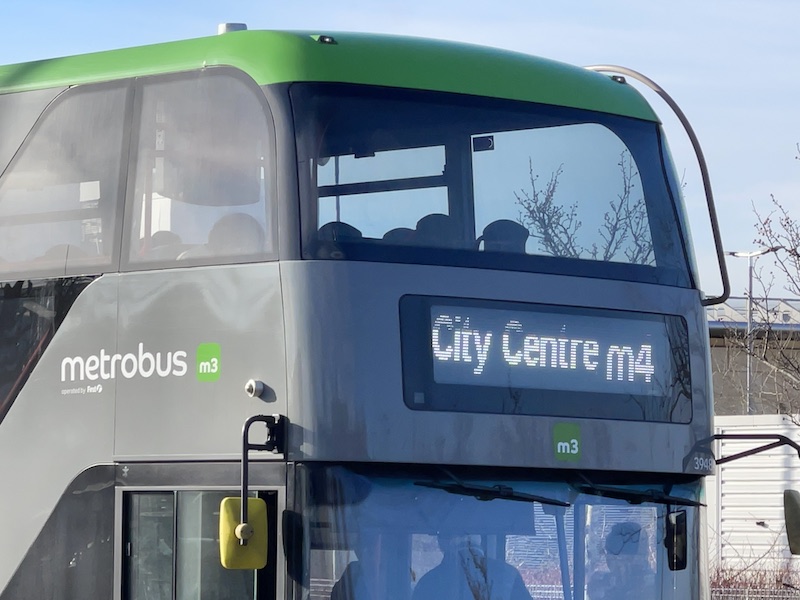
We were reasonably busy during the journey particularly from the University from where we took the fastest route into the city centre using the bus only access junction on the M32 (that is a motorway not a high numbered metrobus route) reaching Cabot Circus in the city centre at 12:40.
The University campus now has the m4 (3 an hour) as well as the m1 (4 an hour) and m3 (which was 6 an hour but now reduced to 3 an hour) providing a quick journey into the city 10 times an hour as well as other routes which follow a slower route.

In the city centre the bus proceeded from Cabot Circus to its terminus at what’s called The Centre but not before a driver changeover at the intermediate bus stop called Broadmead. This took five minutes to accomplish which was rather frustrating for those of us just wanting to travel to the next and final stop. It would be more passenger friendly to do the changeover at the terminus when we’d all left the bus.

The bus stop at The Centre displayed an updated timetable departure list for the m1 and m3 which both had a revised timetable from Sunday, as well as the m4 …
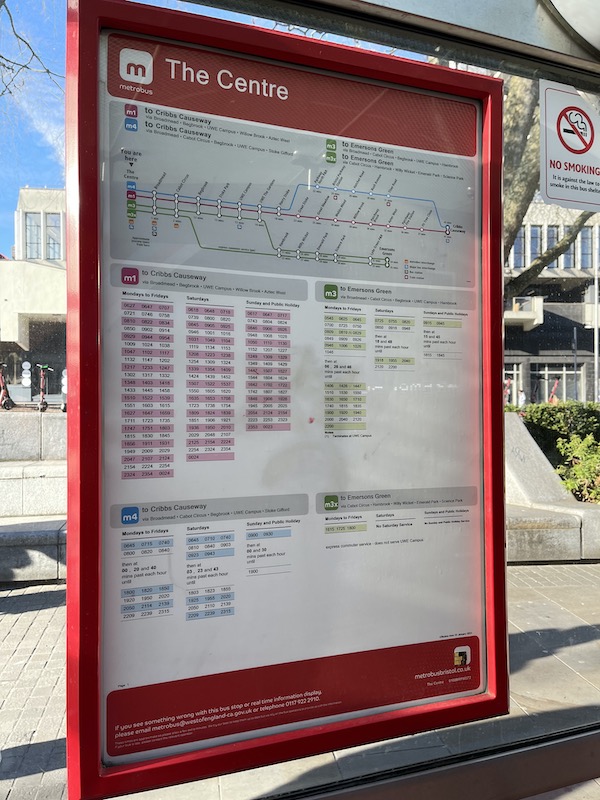
… and a new updated map on the iPoint.

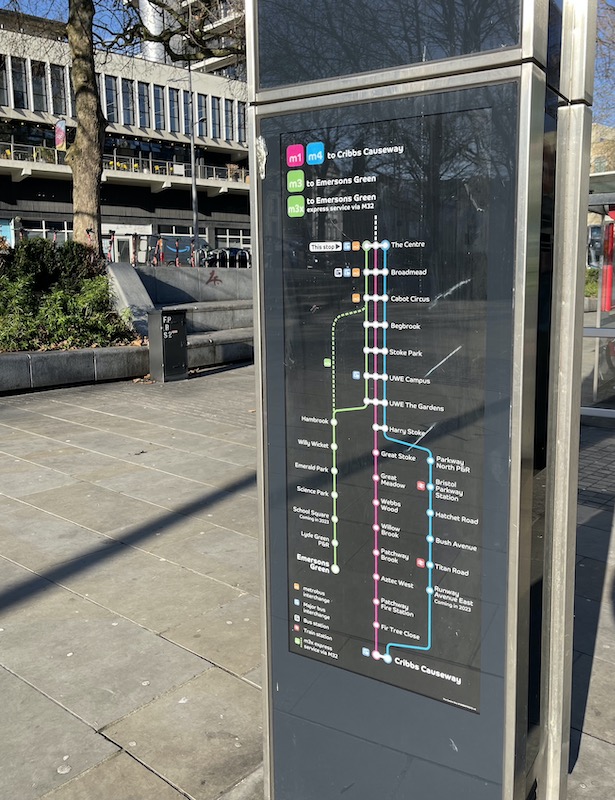
I stepped back at The Centre and completed my rounder back to Bristol Parkway on the original bus I’d travelled to Cribbs Causeway on.
It was a quiet journey especially as we followed an m1 back to the University campus.

It gave me an opportunity to see the bus only slip Road off the M32 from a northbound direction which is always impressive ….

…. as are the associated bus priority measures preventing other vehicles from using it.

As well as Brabazon on the airfield there’s evidence of a considerable amount of house building elsewhere on the m4 route.
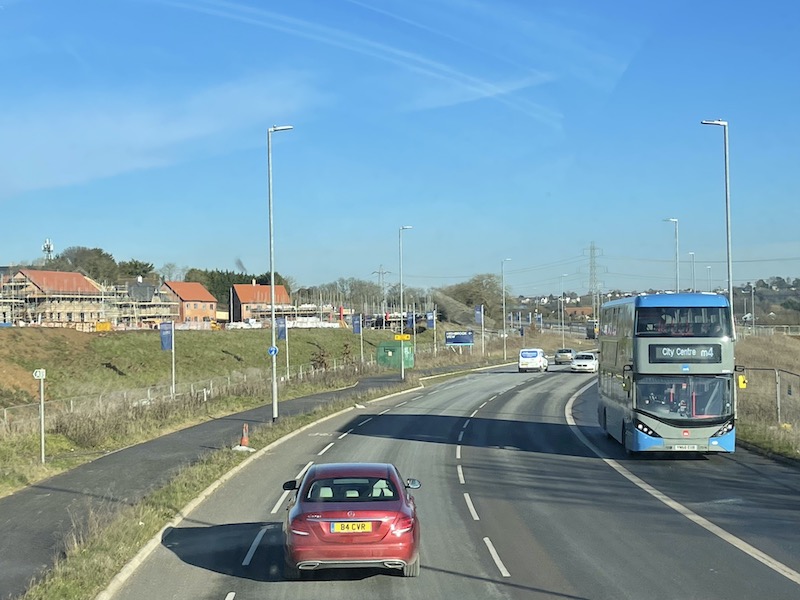
And more to come.

First West of England must be hoping these developments happen soon if they’re operating the m4 as a commercial venture as it looks to me its justification for existence depends on them.

Finally, well done to those responsible for information provision as it was heartening to see everything in place.
Roger French
Blogging timetable: 06:00 TThS

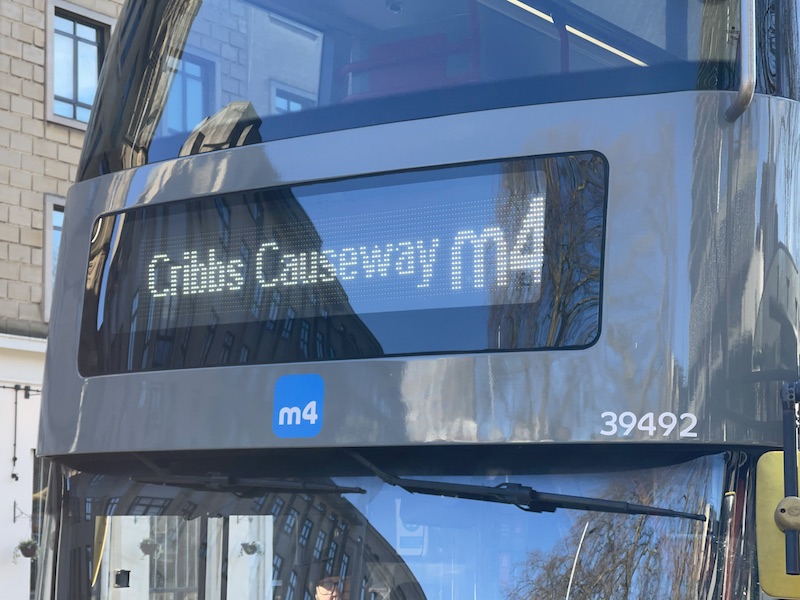
An interesting report. I cannot believe how many buses serve UWE now.
I attended Bristol Polytechnic Frenchay Campus in 1981-3. Then we only had the hourly Hanham worked orbital 380 to Filton once per hour. Upon Hanham’s closure this was worked (as 379 to interwork with 349) by country depot Marlborough Street. Otherwise there were a few peak and lunchtime projections of service 87 from Filton to the Poly. This service was, in compensation, FLF worked!
At other times it was a 25 minute walk to Frenchay proper and service 10 (RE worked) for a direct link to the city.
LikeLike
Theirs a couple of other new bus routes you might want to try out that started on Sunday
319 Kirkby-Skelmersdale, which is supposed to connect with the trains at Kirkby Station
T8 Chester to Corwen, new Trawscymru service, T8 is hourly, but every other hour it connects with the T3 & T10 in Corwen
LikeLike
Thanks for this info.
LikeLike
And DRT is scheduled to start in the Chew Valley in June
LikeLike
Parkway does have an iPoint, but only one, which is supposed to serve the metrobus stops in both directions. You would pass it heading from the station to the city-bound m4 stop, but not the Cribbs-bound one. It is between the statio no building and the multi-story carpark.
And a minor correction re the buses at UWE – the m3 is now only every 20 minutes. It was every 10, with alternate journeys being ‘shorts’ only running Centre to UWE. These short journeys have in effect become the m4 journeys.
LikeLike
Ah; many thanks for this. I’ll update the post.
LikeLike
Another new service that launched this week is the 319 RailLink that runs fast via the motorway from Skelmersdale to Kirkby every 30 minutes (every hour evenings and Sundays), timed to connect with trains to/from Liverpool. Coincidentally (?) starting on the same day as the new class 777 trains debuted on the Kirkby line.
LikeLike
Interesting, thanks.
LikeLike
Spoiler alert!
Apparently you can’t as yet purchase a combined through bus-rail ticket on the bus, thus negating the integrated transport journey this service is designed to offer. Something the metro mayor (or whoever is responsible) needs to address.
LikeLike
The Hatched lines at the Bus Stop shown have a broken line edge so can be used to overtake a Stationary Bus – if safe to do so. Highway code: 130
Areas of white diagonal stripes or chevrons painted on the road. These are to separate traffic lanes or to protect traffic turning right.
If the area is bordered by a broken white line, you should not enter the area unless it is necessary and you can see that it is safe to do so.
If the area is marked with chevrons and bordered by solid white lines you MUST NOT enter it except in an emergency.
Laws MT(E&W)R regs 5, 9, 10 & 16, MT(S)R regs 4, 8, 9 & 14, RTA sect 36 & TSRGD 10(1)
LikeLiked by 1 person
New maps and timetables – you must be in seventh heaven !
LikeLike
I was not surprised to hear that you saw an m3 branded bus on the m4 route. Sadly I now often see incorrectly branded buses not only on metrobus routes, but on First Group services accross the West of England. I very rarely saw branded buses on the wrong routes when the previous MD was in charge!
LikeLiked by 2 people
I believe that one of the m4-branded vehicles had failed earlier; better the wrong bus than no bus!
But yes, current allocation of route-branded vehicles across First WoE is shocking – metrobus m1 was pretending it was Citylines East on Friday…
LikeLike
I think route branding in Bristol has gone a bit Go North East, ie a mish mash of clashing styles. Some routes have coloured fronts on otherwise standard First livery and others are branded “City Lines” and are in a full coloured livery for each route.
Metrobus is actually a watered down BRT. It was supposed to have tram style bendy buses like Belfast (According to early project artist impressions), but unfortunately, it evolved into just nice deckers. Good points are that of bus fare payment was retained, dual door buses specified, high quality bus stops with shelters, info, iPoints etc.
But to the non bus user it doesn’t look like the rapid transit system it was promoted as.
LikeLiked by 1 person
Unfortunately? With journey times of up to 40 minutes or so I would much prefer the nice double deckers – and they must surely be safer on the M32 as well.
LikeLike
Meanwhile in neighbouring Swindon a Bus Summit was held to try to save the service there from wholesale cut. I have not seen any outcomes from this meeting yet though
LikeLike
The article suggests that passengers cannot buy a ticket on board with cash at Bristol Parkway, and possibly elsewhere on the route. That is something that I find annoying. How many barriers to travel do we need to put in?
I realise that there may be a machine nearby, but when the bus is every 20 minutes, that is a big unnecessary penalty for not knowing the requirement. Millions spent on speeding up the journey and then more time than that lost due to ticketing.
LikeLike
metrobus is cashless, yes. Payment is by the app, by contactless, by tap&cap or a ticket bought at the iPoint.
Most passengers seem to be good with this now, as it has been in place in the other metrobus routes since inception.
The wider story in Bristol is that uptake of mTickets on the app is massive as for a couple of years it was cheaper than any other means. Cash use is low as a result – First have stopped accepting the Bristol Pound now, too.
LikeLike
Many thanks for this – encouraging about the timetable info at stops!
I really liked your ‘Inside Track’ in Buses magazine re Community support groups. I hadn’t realised that the Rail groups were mainly funded by the rail operators – that seems a fair division: the company provides the money and physical resources, the groups provide labour (often skilled), enthusiasm and local knowledge. Both sides benefit.
As you say, don’t let’s re-invent the wheel! – but how to get the wheels turning for buses? The main aims will be to improve bus-stops (repair/clean/supply with good info), establish local networks for publicity, and get feed-back about what people want etc.. Leads to better service with more passengers = happy users + happy management. Doesn’t really sound difficult, does it?
Perhaps the DfT could be encouraged to put some money to get an operator to pilot a scheme. The management would have to be keen, and know at least one individual in the area with whom they could work. Then publicise a village-hall or pub room meeting (company supplies refreshments) to set up a community group. Company offers to repair bus-stops and supply groups with means to keep them clean, plus passenger info, and to hold regular meetings. Invites views, comments on services, and formation of group of interested and active members. Establish a secretary/leader to keep members details and regularly inform members of progress etc..
I think bus-stops should then be in the control of the group, or trusted group members (the rail groups will know how this works). For me, every bus shelter should have a large display panel with a list of the buses passing (Very Large Letters), a list of the buses at the stop opposite (Large), a full time-table (Regular), contact telephone no and web-site, and details of the Community group. Plus a map, showing connections to rail and other buses. And how to get back. If the operator would commit to assembling and keeping these details up-to-date, it might give them a better feel for all that their service can do for its users (not just for shopping). The group members would commit to keeping the bus shelter display up-to-date and clean & readable; their reward would be the establishment of reliable and well-used services, and regular contact with the management.
LikeLiked by 2 people
VIX technology seem to have a low cost solution to up to date bus stop information. TfL seem to be trailing it and a consortium of LA’s including Cambridge
The displays use Epaper. The big benefit being it does not need a power supply. Running a mains supply to a bus stop can be prohibitive costing several thousand pound a stop. The epaper displays can run on batteries for a claimed 3 years and in suitable locations can be used with a small solar panel
These panels assuming they have a reasonable life must be cheaper than trying to maintain up to date paper timetables. They can also give real time information as well as information about disruptions and diversions
LikeLike
There was an unfortunate episode shortly after metrobus was launched whereby it was undermined by one of the participating local authorities which started major roadworks, disrupting metrobus severely, leading to the previous First West of England MD publishing an open letter.
https://cbwmagazine.com/managing-director-issues-an-open-letter-to-first-bristol-customers/
I thought at the time that a tram with its reserved track wouldn’t have been affected to the same extent. This is something bus rapid transit promoters need to pay attention to, when telling the public that “it’s as good as a tram but cheaper and more flexible “, what do they really mean by that? I believe that the Cambridge guided busway south of the station is still coned off and out of use? Another example BRT “flexibility”.
LikeLike
The map you posted here of the Bristol bus routes looks rather like a railway map of Wales!!
LikeLike
TfW are putting on a T8 connecting Corwan with Chester
LikeLike
Re Peter Brown’s comment (re the chaos caused by roadworks at the start of the metrobus project), I am continually amazed by the lack of action by the bus industry on this issue. Very noticeably, the commercial bus companies have made buses themselves very reliable , so that roadworks now appear to be the biggest cause of delays. Yet almost any Tom, Dick or Harry of a utility company – and the local authorities – can seriously retard traffic. If there is good notice, cars and some commercial goods vehicles can avoid the blockage, but buses can’t without serious effect on their service to customers, and often little notice seems to be given. The works frequently seem inactive for long periods.
I think the issue is serious – these delays are too frequent, they badly damage bus-users’ trust in the service, and put a brake on growth of the customer base.
My suggestion: causing traffic delay should entail a substantial fee, which would be spent on:
1) Publicising alternative routes for cars etc. including big notices by the roads affected, for at least two weeks in advance, and clear details at all bus stops of affected services – which may be for miles downstream of the works.
2) Paying for sufficient extra buses to enable no drop in bus frequencies, and for the companies’ time and costs in arranging these.
Surely the big groups, acting together, have the political ‘wellie’ to make this happen?
Even for ‘good’ roadworks, such as resurfacing etc., this would encourage efficiency, and getting the ‘offenders’ to arrange roadworks jointly so that everything gets done at the same time.
LikeLike
Is that southern link still laying abandoned 6 years post-construction?! Included the expensive flyover to the park and ride… any news?
LikeLike
Yes the “South Bristol Link” is a new road for all vehicles (built by the Metrobus project) to open up this part of Bristol. However as the area is undeveloped, the commercial operating model for Metrobus meant that service isn’t viable. The route was quietly dropped from maps etc. A local MP moticed made a fuss and I believe a supported service is planned.
What annoyed me about this is that a bus project was used to fund a new road, which to me should come from the highways budget.
LikeLike
Isn’t most of metrobus basically just new road projects funded under the guise of public transport?
Stoke Gifford Bypass, South Bristol Link, Gipsy Patch bridge,…
LikeLike
Colly, pretty much, but not quite as blatant as Sheffield “Steellink” which is literally just a new road along which a new bus service runs.
When BRT projects are watered down to this extent it undermines future such proposals in the eyes of a sceptical public, who, when promised, “it’s like a tram but cheaper and more flexible” they know what they will get is just a bus.
LikeLike
More Bristol disfunction. The city mayor wants an “underground”, the metro mayor doesn’t. The local paper always illustrates articles with a picture of a tube train, just to emphasis the unaffordability of the idea in peoples’ minds. I’ve never seen any details of what format such a system would take, tram based, fully automated like the DLR or Copenhagen etc.
https://www.bristolpost.co.uk/news/bristol-news/bristol-underground-would-cost-18bn-8187375
LikeLike
Seems like a high-quality, densely-packed service that Bristol and its surroundings need, but it’s a shame the trimmings of the non-Metrobus network had to be sacrificed for its success… Still, very comfy seats, the added incentives to entice passengers onto buses doing a great job (USBs, next stop announcements), along with a fantastic feeling of overtaking cars in the bus lanes and bus only routes. The new bridge also completely transforms the image, it just seemed like an entirely different location!
LikeLike